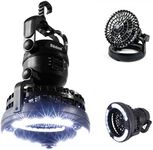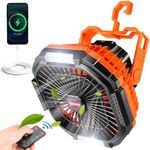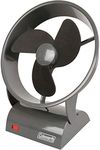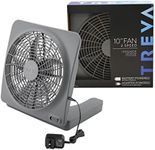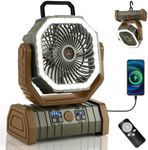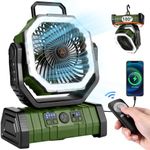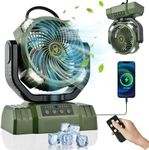Buying Guide for the Best Camping Fans
Choosing the right camping fan can make your outdoor experience much more comfortable, especially during warm nights or in stuffy tents. When shopping for a camping fan, it's important to consider how you'll use it—whether you need it for a solo trip, a family tent, or even for use outside the tent. Think about portability, power source, and how long you'll need it to run. Understanding the key features will help you find a fan that fits your camping style and keeps you cool when you need it most.Power SourceThe power source refers to how the fan is powered—common options include batteries, rechargeable batteries, USB, or even solar power. This is important because it determines how and where you can use the fan. Battery-powered fans are convenient for remote locations, while USB or rechargeable fans can be topped up with a power bank. Solar fans are eco-friendly but depend on sunlight. If you camp in places without electricity, look for fans with long-lasting batteries or the ability to recharge with portable power banks. For car camping or sites with outlets, plug-in or USB fans can be a good fit.
Size and PortabilitySize and portability describe how big the fan is and how easy it is to carry. This matters because you want a fan that fits your tent and is easy to pack. Small, lightweight fans are great for backpackers or solo campers, while larger fans can move more air and are better for family tents or group camping. If you have limited space or need to carry your gear over long distances, choose a compact, foldable fan. For car camping, you can opt for a larger, more powerful model.
Airflow (CFM or Fan Speed)Airflow, often measured in CFM (cubic feet per minute) or described by fan speed settings, tells you how much air the fan can move. This is important for cooling effectiveness. Low airflow fans are quieter and use less power, suitable for small tents or personal use. Medium airflow fans balance noise and cooling, good for most tents. High airflow fans are best for large tents or outdoor use but may be louder and drain batteries faster. Consider your tent size and how much cooling you need—pick a fan with adjustable speeds for flexibility.
Battery Life/Run TimeBattery life or run time indicates how long the fan can operate before needing new batteries or a recharge. This is crucial for overnight use or multi-day trips. Short run times (a few hours) are fine for short naps or occasional use. Medium run times (6-10 hours) cover most overnight needs. Long run times (10+ hours) are best for extended use or hot climates. Think about how long you'll need the fan to run each night and whether you'll have a chance to recharge or replace batteries.
Noise LevelNoise level refers to how loud the fan is when running. This matters because a noisy fan can disturb your sleep or quiet time in nature. Quiet fans are ideal for sleeping or relaxing, while louder fans may be acceptable for outdoor use or if you need strong airflow. If you're a light sleeper or value peace and quiet, look for fans advertised as 'quiet' or 'low noise.'
Mounting OptionsMounting options describe how you can set up or attach the fan in your tent or campsite. Some fans have hooks, clips, or stands, making them versatile for hanging from the tent ceiling, clipping to a pole, or standing on a surface. This is important for directing airflow where you need it most. If you want to cool the whole tent, a hanging fan is useful. For personal cooling, a tabletop or clip-on fan works well. Consider your tent layout and how you prefer to position the fan.
